嘉德首席纹章官
官僚 来自维基百科,自由的百科全书
嘉德首席纹章官(英语:Garter Principal King of Arms)是联合王国纹章管理机构纹章院的高级纹章官职务,设立于1415年。
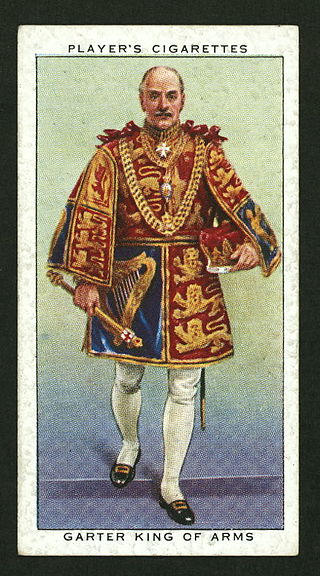
嘉德纹章官就纹章院管理事务对司礼大臣负责。他亦是英国君主在礼仪方面的主要顾问,对英格兰、苏格兰与北爱尔兰的纹章事务特别负责,并对英联邦内除加拿大以外的成员国负责(加拿大的纹章事务由加拿大纹章局负责)。他还担任嘉德勋章的高级纹章官,所有纹章院认证纹章之授予文件上都有嘉德纹章官的印信与签名。
嘉德纹章官负责在前任英国君主崩殂后宣布新任君主。登基会议会在伦敦市中心的圣詹姆士宫召开会议,决定新任君主。一经新君在议会完成宣誓,嘉德纹章官便会步入俯瞰修道庭院的宣誓露台宣告新君[1][2]。
现任嘉德纹章官为大卫·怀特。
历史
就任于1417年的威廉·布鲁日被认为是首任嘉德纹章官,他被任命的确切日期已经不得而知。
约翰·安斯蒂斯曾发现一份盖有亨利五世御玺、发布于1417年5月22日的法令。其中布鲁日被以其先前头衔吉耶纳高级纹章官(Guyenne King of Arms)称呼;该法令要求经加盖王国国玺任命的另一人负责保护跟随国王出国旅行的布鲁日的人身安全。
安斯蒂斯随后进一步指出了两个更为有力的证据:(1)布鲁日与嘉德骑士团于1422年(或1423年)签署的一份有关退休金协议的正式法律文件中交代了布鲁日先前被任命为嘉德骑士;(2)于1417年9月3日(或13日)颁布的一项法令中提到了“Garretier Roy d'armes des Anghis”。 鉴于亨利五世于1417年7月27日前往法国,可以推断布鲁日是在当年7月下旬被任命的[3]。
但此论后来遭休·斯坦福·伦敦(Hugh Stanford London)质疑。伦敦所公布的材料表明布鲁日被任命的时间较先前安斯蒂斯的结论要早两年。威廉·布鲁日的父亲理查德·布鲁日曾于1415年7月4日留下一份分为两部分的遗嘱:一部分关于。其葬礼安排、慈善遗产与留给妻子的遗产;另一份则关于其个人遗产。虽然记录于伦敦登记处的前者只提到了理查德·布鲁日的妻子,但记录于坎特伯雷大主教亨利·齐契利处的后者提及了其子女。其中威廉被称作 “Gien”“Gyen” “Gartere”,威廉的妻子则被称为“艾格尼丝·嘉德”(Agnes Garter)。然而其他登记处对遗嘱第二部分的记录标注时间为1418年或1419年,因此史学家欧内斯特·雅各布推测上述论据或为误读。但伦敦则辩称后世对该遗嘱的注解皆以“嘉德”或“吉耶纳”(Guyenne),抑或干脆全以“嘉德”指称威廉·布鲁日,倘若这是误读,其妻艾格尼丝亦不会仅被简称为“嘉德”。相反,伦敦推测理查德·布鲁日在写遗嘱时忘记了在文中称呼其新任命的儿子的“嘉德”头衔,后来则将“嘉德”与儿子的就头衔一并写入了遗嘱。
彼得·贝根特批评了这一观点。他在1415年至1417年的记录中发现,威廉·布鲁日仅被称作“吉耶纳”或同等头衔“阿基坦高级纹章官”,这与伦敦的推断显然冲突。他认为若非误读,第二份遗嘱可能因为理查德·布鲁日给家人留下了更多财产而在1415年之后才完成。
亨利五世任命嘉德首席高级纹章官领衔全体掌礼官。
嘉德首席高级纹章官据称或许拥有两重身份,其一与嘉德勋章有关,另一个则是纹章院院长。如此一来他不仅需要在君主与众骑士列席的嘉德骑士团理事会面前宣誓,亦需对司礼大臣宣誓,因此他被封有“最高贵的嘉德勋章首席纹章官”与“首席英格兰纹章官”两个头衔。
嘉德纹章官必须是继承有纹章的英格兰人,并有权任命一名纹章官作为副手。传统上认为嘉德纹章官既不能担任骑士,也不能成为神职人员;但历史上有过外国人担任该职位的例子;自亨利七世登基以来许多任嘉德纹章官都被授予了骑士身份,其中一位更是成为了巴斯骑士团成员。嘉德纹章官有权纠正或修改纹章、向满足资格者授予纹章、向上议院提交新贵族家谱、分配获授纹章者在议事厅的席位。
纹章
嘉德首席纹章官纹章自1520年左右启用。
预算
除由英国王室支付的49.07英镑的年薪以外,英国财政部也对其为政府的服务支付薪酬。 截至2021年1月27日,财政部共计支付给时任嘉德纹章官托马斯·伍德考克爵士651,515英镑。此外,自2018年以来,财政部每年为嘉德纹章官提供3.5万英镑的费用基金,用于支付秘书支持、清洁和邮费等业务费用。截至2021年1月27日,嘉德纹章官共收到74,579.02英镑用于支付费用[4]。
历代嘉德首席纹章官
- 历代嘉德首席纹章官
-
一份1430年左右的插图手稿,绘有首任嘉德首席纹章官威廉·布鲁日跪在圣乔治面前。布鲁日于1415年或1417年被任命。
-
爱德华·沃克爵士,在英国大空位期间担任嘉德首席纹章官。
-
威廉·杜格代尔爵士,英国著名古董商人,他在1677年至1686年期间担任嘉德首席纹章官,曾到访巡视英国10个市县。
-
约翰·安斯蒂斯,1719年至1744年担任嘉德首席纹章官。
-
斯蒂芬·马丁·利克,英国著名钱币学家,1754年至1773年担任嘉德首席纹章官。他对纹章官的特权尤为看重,曾发起未果的恢复纹章官巡视权的运动。
-
阿尔伯特·伍兹爵士,1869年至1904年担任嘉德首席纹章官,担任嘉德勋爵近35年,但晚年因年事已高年不得不在1902年将许多加冕典礼职责委托给其他纹章官。
列表
| 纹章 | 姓名 | 在任时间 [nb 1] | 备注 | 参考 |
|---|---|---|---|---|

|
威廉·布鲁日 | 不晚于1417年9月[nb 2] –1450年3月9日 | 兰开斯特纹章官理查德·布鲁日之子。布鲁日于1398年被任命为切斯特纹章官,该职务使其成为威尔士亲王与切斯特伯爵亨利(即后日的亨利五世)家族的近臣。1407年至1410年间,他被亨利四世雇佣。1413年,他被任命为吉耶纳高级纹章官[6],并于1415年随同亨利五世赶赴阿金库尔战役;他被委以许多外交责任,并获封“阿基坦高级纹章官”头衔,与吉耶纳纹章官的头衔交替使用[5]。作为嘉德纹章官,他主持了亨利五世的葬礼,并经常在亨利六世领导下执行外交任务。1421年,他参加了首次英国纹章官会议。1430年,他负责起草嘉德勋章的首个纹章。[5] | |

|
约翰·斯莫特 | 1450年4月3日–1478年7月6日之前 | 约翰·斯莫特的世系不详,但其在格洛斯特郡拥有土地,并有可能是一名律师。他与威廉·布鲁日的一个女儿成婚,可能于1444年担任吉耶纳高级纹章官,并于1449年被派往外交使团;而其被任命为嘉德纹章官时,据信确为吉耶纳高级纹章官。斯莫特曾在许多外交使团中供职,包括1468年出席玛格丽特公主与大胆查理的婚礼与次年前往勃艮第公国的嘉德出使(Garter Misson)[7]。 | |

|
约翰·怀特 | 1478年7月6日-1504年3月或4月 | 约翰·怀特的世系不详,但其父有可能是第一代萨默塞特公爵约翰·博福特继承人之一、曾短暂担任克里克莱德国会议员的威廉·怀特(William Wrythe)。怀特于1477年前担任福孔纹章官(Faucon Herald),并于是年被任命为诺罗伊高级纹章官,他参加了爱德华四世的葬礼与理查三世的加冕礼。理查三世后来于1483年任命他为嘉德纹章官,但他与于1485年1月4日辞职,后来又在亨利七世登基后的1486年2月13日正式复职[8][9]。怀特曾被派至前往苏格兰、爱尔兰、布列塔尼、加来、勃艮第乃至拜访神圣罗马帝国马克西米连一世的外交使团[8]。 | |

|
托马斯·莱奥斯利爵士 | 1505年1月26日-1534年11月15日 | 莱奥斯利为约翰·怀特长子,曾任瓦林福德助理纹章官(Wallingford Pursuivant),先后为亚瑟·都铎与亨利王子(即后来的亨利八世)工作过[10]。担任嘉德纹章官期间,他曾跟随亨利八世前往泰鲁阿讷、出席金帛盛会、前往加来,并参与了对费德里科·达·蒙特费尔特罗、费利佩一世、斐迪南一世与弗朗索瓦一世 (法兰西)的嘉德出使;此外在内政方面,他参与了亨利七世葬礼、亨利八世加冕礼与1511年的威敏斯特争霸赛。他亦有效垄断了纹章的颁给权力并被允许进行巡查探访(但另一位纹章官于1530年亦被授予上述权力)[10] | |

|
托马斯·沃尔 | 1534年12月9日-1536年6月27日 | 沃尔之父曾任Norroy and Ulster King of Arms,沃尔则于1521年被任命为红十字助理纹章官,并于1525年晋升为温莎纹章官。他于16世纪20年代至30年代供职于许多==诸多外交使团,曾前往法兰西、意大利与奥地利,也于1535年参与了对詹姆斯五世的嘉德出使。他还在1530年编纂了《沃尔纹章书》(Wall's Book of Arms)[11]。 | |

|
克里斯托弗·巴克爵士 | 1536年7月15日-1550年1月2日 | 巴克之父来自约克郡斯多克斯雷,其母则来自泰恩河畔纽卡斯尔一个叫作Carlill或Carlisle的家庭; one of his uncles was Christopher Carlill, Norroy King of Arms. He was in Charles Brandon, Duke of Suffolk's service as Lisle Pursuivant (c. 1513) and then Suffolk Herald (c. 1517), before being appointed Richmond Herald at the college in 1522 and Norroy in June 1536. He was attached to foreign missions between 1514 and 1544, the early instances with the Duke of Suffolk and later including work with the English embassy in Spain and at the peace talks at Cambrai in 1529. He also oversaw the funeral of Henry VIII and the coronation of Edward VI and managed to maintain reasonably friendly relations with the provincial Kings of Arms. | |

|
吉尔伯特·狄思杰爵士 | 1550年4月29日-1584年10月3日 | Dethick claimed descent from Derbyshire gentry, but this is unlikely; for his father was a German-born armourer made a denizen by Henry VIII. He may have been in royal service before his first appointment at the college, as Hampnes Pursuivant, in 1536; promotions to Rouge Croix (1540) and Richmond (1541) followed and in 1547 he became Norroy King of Arms. He was a member of the original Society of Antiquaries and was often sent on missions abroad as a herald. He travelled with Lord Somerset to Scotland in 1549 and was nearly shot at Musselburgh; in England, he was sent to force the surrender of rebels led by Robert Kett. Described as a "sound" genealogist, he also made 140 grants of arms as Garter and secured the college's future home at Derby Place from Queen Mary. | |
| 1584年至1586年职位空缺,此间时任克拉伦修高级纹章官罗伯特·库克行使嘉德首席纹章官职权。 | ||||

|
威廉·狄思杰爵士 | 1586年4月21日-1606年12月10日(解职) | The second son of Sir Gilbert Dethick, Garter, William Dethick was educated at St John's College, Cambridge. His father also tutored him and secured his appointment as Rouge Croix Pursuivant in 1567; he succeeded him as Garter and bribed the signet clerks to include a clause in his patent allowing him to make visitations, arousing tension with the provincial kings. A new patent was eventually regranted, removing the rights, but Dethick garnered controversy for verifying false pedigrees, his poor behaviour and quarrelling with fellow heralds. He had treasonously supported the marriage proposal of Mary, Queen of Scots, and the Duke of Norfolk, but Elizabeth I forgave him and it eventually earned him the support of James I. His critics and enemies put enough pressure on the King, however, for Dethick to be dismissed in 1604; although defiant, he backed down and accepted an annuity two years later, before dying in 1612. | |

|
威廉·西格爵士 | 1607年1月17日-1633年12月10日(或13日) | Segar's parentage cannot be confirmed, but he was of Dutch origin and trained as a scrivener. He was appointed Portcullis Pursuivant in 1585 and Somerset Herald three years later, before Norroy King of Arms in 1597 (patent 1602). He sided with Garter Dethick against successive Clarenceux Kings of Arms, before being appointed Deputy Garter in 1603. He was appointed Garter in January 1604, but could not obtain a patent until Dethick finally resigned in 1607. One of Segar's rivals, Ralph Brooke, tricked him into confirming a false coat of arms to a pretend gentleman[需要解释] in 1616; James I had them both imprisoned for several days. Segar authored at least 13 manuscript and printed works, and has been described as a "conscientious herald and a formidable scholar", but like many of his contemporaries, "he authorized many pedigrees giving most improbable descents from fabulous ancestors". | |

|
约翰·伯勒爵士 | 1633年12月27日-1643年10月21日 | Borough's maternal grandfather was a Brabanter, but parents lived at Sandwich in Kent. He was part of Sir Francis Bacon's household by 1618, and a Member of Parliament for Sandwich (1621) and Horsham (1624–26). By his first marriage, he was connected with Sir Robert Cotton, who may have helped his appointment as Keeper of the Records in the Tower of London in 1623; when Bacon fell from power, it may have been Cotton who assisted Borough in obtaining the Earl of Arundel's patronage and he entered the College as Mowbray Herald Extraordinary in 1623. Later that year, he was appointed Norroy King of Arms. He accompanied Charles I on his trip to Scotland in 1633 and was ambassador to the Holy Roman Emperor in 1636. Despite being highly regarded in his lifetime for his antiquarian knowledge, Borough wrote only one book: The Soveraignty of the British Seas. | |

|
亨利·圣乔治爵士 | 1644年4月6日-1644年11月5日 | The son of Sir Richard St George, Clarenceux King of Arms, details of Henry St George's early life and education are absent. He was employed by the College in c. March 1609 and appointed Rouge Rose Pursuivant Extraordinary later that year. Promotion to Bluemantle Pursuivant followed in 1611 and Richmond Herald in 1618 before he was promoted to Norroy King of Arms in 1653. As Richmond, he travelled to France with William Le Neve and was Segar's deputy on a Garter mission to Sweden in 1627. He was suspended for forging a grant of arms in 1639, but pardoned in 1640; during the Civil War, he travelled with Charles I to Oxford and is said to have received a Doctorate in Medicine from the University there (1643).[12] | |

|
爱德华·沃克爵士 | 26 February 1645 – 10 February 1677 | Walker was a native of Somerset and entered the Office of Purveyance before he was employed by the Earl of Arundel in 1633; he was then appointed Blanch Lyon (1635) and Rouge Dragon Pursuivants (1637), Chester Herald (1638) and Norroy King of Arms (1644). He was also Secretary at War against the Scots in 1639 and, a royalist, he attended Charles I during the Civil War, serving in a number of posts, including Secretary for War. After the royalist defeats at Naseby, Newark and Oxford, Walker went to France but returned as Charles I's chief secretary during the failed negotiations at Newport. After the King's execution, he travelled with Charles II in exile, who confirmed him as Garter in 1650. At the Restoration (1660), he displaced Sir Edward Bysshe, who had "intruded" in the office of Garter since c. 1643. Walker controversially granted arms without reference to the provincial kings of arms and tried to unify their offices with his; he also clashed with the Earl Marshal, who forced the Kings of Arms to jointly issue grants from 1673. After his death, many of his collections came to the college; his account of Charles II's coronation was posthumously published in 1820. | |

|
爱德华·比希爵士 | 因英格兰内战爆发于1643年左右职务行使中断,1646年10月20日由议会认定,1660年免职 | The eldest son of a Surrey gentleman, Bysshe was a Member of Parliament for Bletchingly, Reigate and Gatton. He was a Parliamentarian who took the covenant, intruded in Garter's office (c. 1643) and served on committees to regulate the heralds in 1641 and 1645. Parliament confirmed him as Garter on 20 October 1646 and as Clarenceux King of Arms in 1650. Although he resigned from the latter eight years later, he was re-appointed in 1661, shortly after he was deposed as Garter during the Restoration. According to Godfrey and Wagner, he was a good armourist; however, his visitations provide only brief accounts of the families concerned, and he neglected his duties, both parliamentary and heraldic, from the 1660s. Despite these failings, he had ensured that the college and its records remained open during the Interregnum, much to the benefit of antiquaries, including his colleague Sir William Dugdale. | |

|
威廉·达格代尔爵士 | 1677年4月26日-1686年2月10日 | The son of a Warwickshire clergyman, Dugdale was privately educated before attending a free school in Coventry and never went to university. His earliest antiquarian works were concerned with his native county, where, inspired and helped by other antiquaries, he collected material for a history. His talents earned him the respect of leading antiquarians, including Sir Henry Spelman, and as the Civil War developed, Dugdale travelled around England recording records, coats of arms and inscriptions in English cathedrals and churches. This work culminated in Monasticon Anglicanum, a work which helped to establish the use of charters as historical evidence; his other great works include The Antiquities of Warwickshire and The Baronage of England, which have helped to solidify his legacy as a great antiquarian. According to the Oxford Dictionary of National Biography, "the scale of his operations was greater than any previous endeavour, and its achievements were astonishing". Dugdale had been Blanch Lyon, Rouge Croix, Chester and Norroy before his Gartership and created, donated or contributed to a number of valuable heraldic and genealogical records at the college, in addition to the ten visitations he personally conducted. | [13] |

|
托马斯·圣乔治爵士 | 11 March 1686 – 6 March 1703 | Sir Thomas St George was the eldest son of Henry St George, Garter, but his early life and education are obscure. He was appointed Somerset Herald at the Restoration in 1660 and became Norroy King of Arms 20 years later. He served as a deputy for Sir Edward Walker on a Garter mission to Dresden in 1669. As Garter, he travelled to The Hague with the King in 1691, but appointed Gregory King as his deputy on all the other missions he should have made. He inherited his father's manuscript collections, and Peter Le Neve purchased his papers; they are now scattered, with a number in the British Library. | |

|
小亨利·圣乔治爵士 | 16 June 1703 – 1715 | The eighth son of Sir Henry St George, Garter, Henry the younger became Garter after appointments as Richmond (1660), Norroy (1677) and Clarenceux (1680). He was remembered by contemporaries as "a timorous animal" and "incommunicative, sordid and of little learning", but he visited 12 counties as Clarenceux and donated the profits from six towards the rebuilding of the college after the Great Fire of London. His manuscript collection was sold after his death and later sold again at auction; some have returned to the college, but most remain scattered in collections. | [14] |

|
约翰·安斯蒂斯 | 2 April 1714 (reversionary) – 1744 | Anstis was the son of the registrar of the archdeaconry of Cornwall. Educated at Exeter College, Oxford, he entered the Middle Temple in 1690 and became high steward of Cornish tinners two years later; he was called to the Bar in 1699 and conducted work for the House of Commons in 1701. He published Curia Militaris, a defence of the Earl Marshal's jurisdiction in the Court of Chivalry. In 1702 he was elected to Parliament for St Germains and tended to follow the Tory line, but declined to stand in 1705. He was nominated as Carlisle Pursuivant Extraordinary and Norfolk Herald in 1707, was re-elected to Parliament in 1711, appointed Keeper of the Record in 1712 and received a reversionary patent for Garter's office in 1714. He duly claimed Garter after St George's death, although John Vanbrugh was nominated instead and Anstis was then in prison as a suspected Jacobite. After a lengthy legal debate, he was confirmed as Garter on 20 April 1718, took his oath in April the next year and went on to oversee George II's coronation in 1727. His son John was jointly Garter with him from 1727. | |

|
小约翰·安斯蒂斯 | 9 June 1727 (with father) – 5 December 1754 | The seventh son of John Anstis, Garter, the younger Anstis was educated privately before matriculating at Corpus Christi College, Oxford, in 1725. Shortly afterwards, he was appointed genealogist to the Order of the Bath and he joined the College two years later as Blanc Coursier Herald. From 1727 he was jointly Garter with his father until the latter's death on 4 March 1744, after which he served alone. He was elected a Fellow of the Society of Antiquaries and received an LLD degree from Oxford University in 1749. | |

|
斯蒂芬·利克 | 19 December 1754 – 24 March 1773 | Leake was born Stephen Martin, the son of a naval officer from Essex; his maternal uncle, Admiral Sir John Leake, left his estate to Martin's parents on the condition that they adopt his surname, which they did in 1721. Despite this and work at the Navy Office, the family lost out in the South Seas crash and Leake was forced to find employment. After joining the Society of Antiquaries and publishing Nummi Britannici historia, he joined the College as Lancaster in 1727 and was promoted to Norroy in 1729 and Clarenceux in 1741. Leake was less interested in genealogy than in the rights and history of the heralds; he petitioned for the college to have a monopoly on the researching of arms and unsuccessfully tried to revive the visitations, a proposal which Anstis and the government opposed. He also opened the college's register for Dissenting and Jewish births and carried out two Garter missions. On his death, his collections passed to his brother, and they were eventually bought by the college. | |

|
查尔斯·汤利爵士 | 27 April 1773 – 7 June 1774 | Born at Tower Hill in London, Townley was the son of a merchant and educated at the Merchant Taylors' School from 1727. He bought his appointment as York Herald in 1735; he was promoted to Norroy in 1751 and Clarenceux in 1755, but, according to his predecessor Stephen Martin Leake, he received a large fortune around 1755 and neglected his heraldic duties thereafter. He was nonetheless knighted in 1761. A number of his collections are in the possession of the college, including transcribed memorial inscriptions. | |

|
托马斯·布朗恩 | 15 August 1774 – 22 February 1780 | A native of Derbyshire, Browne was a land surveyor who was said to have worked for the Duke of Norfolk and converted his favour into heraldic appointments; the Oxford Dictionary of National Biography records that he carried out works for John Warburton, Somerset Herald. He was successively appointed Blanch Lyon (1727), Bluemantle (1737), Lancaster (1744), Norroy (1761) and Clarenceux (1773) before his appointment as Garter. Despite his success as a surveyor, he was reputed to have known little of heraldry and neglected his duties at the college. | |
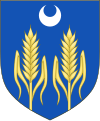
|
拉尔夫·比格兰 | 2 March 1780 – 27 March 1784 | Bigland was the son of a Middlesex tallow chandler whose ancestors have been traced to Westmorland and Lancashire. He was apprenticed to a cheesemonger in 1728 and, after 9 years service, he entered his own trade and carried out his practice for over 20 years. He travelled to the Low Countries and Scotland and supplied cheese to the allied armies during the War of the Austrian Succession; it was on these travels that he began noting down memorial inscriptions, a pursuit to which he would devote his life. He compiled a huge collection of inscriptions relating to Gloucestershire, where he travelled extensively from 1750 onwards. These interests brought him to the college, where he was appointed Bluemantle Pursuivant in 1757 and promoted to Somerset Herald in 1759, Norroy in 1773 and Clarenceux in 1774. A competent and methodical genealogist and draughtsman, he took a particular interest in parish registers and campaigned for their indexing and the inclusion of greater detail in them. After his death, the majority of his Gloucestershire notes and transcriptions were published, although a number remained in manuscript form until the 1990s. | |

|
艾萨克·赫德爵士 | 1 May 1784 – 29 April 1822 | A native of Devon, Heard was educated at Honiton Grammar School before serving in the Royal Navy between 1745 and 1751. He then embarked on a career as a merchant: first in Bilbao, Spain, and then in London. An appointment as Bluemantle Pursuivant followed in 1759, with a promotion to Lancaster Herald two years later; in 1774, he was appointed Norroy King of Arms and Brunswick Herald, before a promotion to Clarenceux in 1780; he served as Earl Marshal's Secretary (1782–84) and resigned as Brunswick in 1814. Heard was a proponent of the landscape heraldry which proved popular in the late Georgian period, and, inspired by his earlier travels, took a precocious interest in American genealogy. As a long-serving herald, his genealogical practice was large and much of his manuscript collection ended up in the college. | |

|
乔治·内勒爵士 | 11 May 1822 – 28 October 1831 | The son of a Gloucestershire surgeon, Nayler practised as a miniature painter before buying his way into the offices of Blanc Coursier Herald and Genealogist of the Order of the Bath in 1792. He used the same means to obtain a place in the College as Bluemantle Pursuivant a year later; promotion to York Herald followed in 1794 after the accidental death of its incumbent. Further appointments as King of Arms to the Royal Guelphic Order and the Order of St Michael and St George (1815 and 1818 respectively) followed before he became Clarenceux King of Arms in 1820 and served as deputy Garter at George IV's coronation in 1821. As Garter, he continued to run a large practice at the College and conducted missions to France, Denmark, Russia and Portugal. Much of his earlier heraldic career involved disputes with the other heralds about his sole right to record pedigrees of the Knight of the Bath; despite objections, he compiled 47 volumes, which are now in the college's possession. He also worked on a history of George IV's coronation, which was only partially published in his lifetime, and a manuscript history of the Order of the Bath, also owned by the college. | |

|
拉尔夫·比格兰爵士 | 26 November 1831 – 14 July 1838 | Bigland was born on 1 May 1757, the son of Joseph Owen of Salford, Lancashire, but changed his surname in 1774 at the desire of his maternal uncle, Ralph Bigland, Garter. That year, he became Rouge Dragon Pursuivant and was appointed Richmond Herald in 1780. Promotions to Norroy (1803) and Clarenceux (1822) King of Arms followed and his appointment as Garter marks the last time an officer has held all three Kingships. He was knighted in 1831.[15] | |

|
威廉·伍兹爵士 | 23 July 1838 – 25 July 1842 | By tradition, Woods was reputed the son of the 11th Duke of Norfolk, but he bore the arms matriculated in 1812 in Scotland by one George Woods, a tailor of London and brother to a comedian called William. Whatever the case, details of his early life are also sparse. He was appointed Secretary to the Knights Commander and Companions of the Order of the Bath in 1815 and then Registrar of the Royal Guelphic Order later that year. He tried for Ross Herald in Scotland in 1816, but his first heraldic appointment was as Bluemantle Pursuivant in 1819; promotions to Norfolk Herald (1825; held jointly with Bluemantle), Clarenceux King of Arms (1831) and deputy Garter (c. 1836) followed.[16] | |

|
查尔斯·扬爵士 | 6 August 1842 – 31 August 1869 | Born in Lambeth, Young was the son of a surgeon and, through his mother, an illegitimate grandchild of the 11th Duke of Norfolk. After studying at Charterhouse, he entered the College as Rouge Dragon Pursuivant in 1813 and was promoted to York Herald in 1820. He took part in ten Garter missions and the funerals of George III, George IV and William IV, as well as the coronations of the last two and of Queen Victoria, and the marriage of the Prince of Wales. According to the Oxford Dictionary of National Biography, Young was an expert on matters of precedence, a prolific genealogist (especially relating to peerage claims) and a competent businessman, whose service as Registrar of the college (1822–1842) and then Garter safeguarded its finances; he also oversaw the construction of its new record room, which now contains most of his books and papers, amounting to 922 volumes. | |

|
阿尔伯特·伍兹爵士 | 2 November 1869 – 7 January 1904 | The illegitimate son of William Woods, Garter, he worked in his father's practice before his first heraldic appointment as Fitzalan in 1837. Portcullis followed a year later, before Norfolk, Lancaster and Brunswick, all in 1841. He took part in Garter missions to foreign states from the 1860s to the 1880s, but old age forced him to delegate his duties during Queen Victoria's funeral and Edward VII's coronation. He maintained a veto over heraldic matters and, in his old age, he refused to retire, guarding his increasingly sluggish practice; the delay this caused in administering orders of chivalry led to the establishment of the Central Chancery of Orders of Knighthood in 1904. He had an "unrivalled knowledge" of ceremonies and a shrewd business sense, but was not a scholar and was described by Wagner and Godfrey as a "deplorable" armorist who was determined that Victorian grants of arms should be distinct and never include simple coats of arms.[17] | |

|
阿尔弗雷德·斯科特-盖蒂爵士 | 8 January 1904 – 18 December 1918 | A clergyman's son and graduate of Christ's College, Cambridge, Scott-Gatty was a co-owner of The Genealogist magazine and revived the granting of heraldic badges. He served as Rouge Dragon from 1880 and York from 1886.[18] | |

|
亨利·伯克爵士 | 22 January 1919 – 21 August 1930 | Burke was a son of Sir Bernard Burke, Ulster King of Arms, and grandson of John Burke, who founded the Burke's Peerage series. Although educated at Trinity College, Dublin, he did not take a degree. He trained for the Bar examination but instead entered the College as Rouge Croix Pursuivant in 1880; a promotion to Somerset Herald followed in 1887 and he became Norroy King of Arms in 1911.[19] During Sir Albert Wood's old age, Burke did much of the work for the coronation of Edward VII, a task made difficult by the long reign of Victoria; he was duly recognised with the CVO.[20] Described by Wagner and Godfrey as an "able genealogist", he was also an authority on armorial china[19] and oversaw corrections to many of the errors in Burke's Peerage which had attracted criticism during his predecessors' editorships. | |
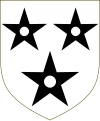
|
杰拉尔德·渥拉斯顿爵士 | 27 September 1930 – 2 June 1944 (retired) | A grandson of Sir Albert William Woods, Wollaston was educated at Harrow and then Trinity College, Cambridge, whence he graduated in 1893 with a law degree.[21] He was called to the Bar in 1899, but joined the College three years later as Fitzalan Pursuivant Extraordinary for the coronation of Edward VII. Appointments to Bluemantle Pursuivant (1906), Richmond Herald (1919), and Norroy King of Arms (1928) followed.[21] Having served as Henry Farnham Burke's deputy for a year,[21] he succeeded him as Garter and oversaw the coronation of George VI; his experience and knowledge of ceremonial proved useful in assisting the young Earl Marshal. Earlier in his career, he was often called on to counsel in Peerage cases.[22] A "most painstaking and skilled herald with special bent to ceremonial", he published The Court of Claims in 1902, 1910 and 1936.[21] After his Gartership, he served as Norroy and Ulster until his death in 1957.[22] | |
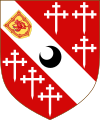
|
阿尔加·霍华德爵士 | 2 June 1944 – 6 December 1950 (resigned) | Howard was descended from the Dukes of Norfolk; he was born in Thornbury Castle, where he lived for many years. Educated at King's College London,[23] he was later admitted to the Inner Temple as a barrister. His first appointment at the college was in May 1911 as Fitzalan Pursuivant Extraordinary and he attended the Prince of Wales' investiture that year.[23] He was promoted to Rouge Dragon Pursuivant that October, followed by Windsor Herald in 1919 and Norroy King of Arms in 1931, to which was added Ulster King of Arms in 1943.[23] After he resigned as Garter, he served as Extra Gentleman Usher to the Queen from 1952 till his death, aged 89, in 1970.[24] | |

|
尊敬的乔治·贝柳爵士 | 1950年12月6日-1961年7月5日 | Born into the Irish peerage, Bellew was educated at Christ Church, Oxford, and served in the Royal Air Force Volunteer Reserve during the Second World War, attaining the rank of Squadron Leader. He served as Portcullis (1922–27) and then Somerset before his appointment as Garter; in the meantime, he had been registrar of the college. The Times called him the equivalent of a chief staff officer during arrangements for the funeral of George VI and the Coronation of Elizabeth II;[25] under the Earl Marshal, he was responsible organising the ceremonies and was knighted in recognition of this work. After a long retirement, spent at his Dower House, Englefield Green, and the Grange, Farnham, he died in 1993.[25] | |

|
安东尼•瓦格纳爵士 | 1961年7月6日-1978年(退休) | Wagner was the son of a schoolmaster and a graduate of Balliol College, Oxford. His first appointment at the college was as Portcullis in 1931, but the Second World War interrupted this. He served in War Office and then the Ministry of Town and County Planning; a keen architectural historian, he helped to draw up guidelines on listing buildings. He was promoted to Richmond in 1943 and left the civil service for the college in 1946. As Garter, Wagner oversaw the funeral of Sir Winston Churchill and the investiture of the Prince of Wales, and was the first director of the Heralds' Museum; after retiring as Garter, he served as Clarenceux until his death in 1995. A leading genealogist and historian of the college, Wagner published a number of important books on the topics, including Heralds of England, Heralds and Heraldry in the Middles Ages, Pedigree and Progress and English Genealogy, alongside several catalogues of the college's manuscript collection;[26][27] in 1957, Oxford University awarded him the degree of DLitt and he was twice knighted, as KCB and KCVO.[26] | |

|
科林·科尔爵士 | 1978年10月2日-1992年(退休) | 科尔在参加二战服役之前从剑桥大学与牛津大学毕业。他于1949年获得律师资格,但对高等骑士法院的兴趣使得他进入纹章院。[28]他后来被任命为菲茨艾伦特设助理纹章官,并于1957年晋升为吊闸助理纹章官,于1966年任温莎纹章官[29]。在任期间,他监督了纹章院的大量修复工作,但他因未能阻止1988年加拿大纹章管理局成立而受到批评。 He conducted business at a leisurely pace and The Telegraph remarked that he would "perhaps have better suited the early Hanoverians". He died in 2001.[29] | |

|
康拉德·斯旺爵士 | 1992年10月5日-1995年(退休) | 斯旺为土生土长的加拿大人,其父为一名皇家加拿大陆军医疗队军官。斯旺先后毕业于西安大略大学与剑桥大学,并在第二次世界大战期间服役于欧洲与印度。他于1962年被任命为纹章院红龙助理纹章官,并于1968年晋升为约克纹章官。约克于2019年逝世。 | |
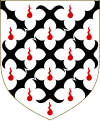
|
彼得·格温-琼斯爵士 | 1995年10月5日-2010年(退休) | 格温-琼斯之父为一名英国皇家炮兵军官[30]。格温-琼斯从剑桥大学三一学院毕业后首先在伦敦从事保险经纪人的工作。他于1967年加入纹章院担任科林·科尔的助理,并在后来与安东尼·华格纳爵士合作。他于1973年被任命为蓝披风助理纹章官[30],并于1983年晋升为兰开斯特纹章官。他被认为是一名坚持精简与创新性几何设计的“作品丰富的”(Prolific)纹章学家。[30] 他于2010年逝世[31]。 | [32] |
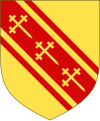
|
托马斯·伍德考克爵士 | 2010年4月1日-2021年7月1日 | 伍德考克毕业于杜伦大学与剑桥大学达尔文学院。他于1975年取得律师资格,但同年转身去做了安东尼·华格纳爵士的研究助理。他于1978年被任命为红十字纹章官,于1982年被任命为萨默塞特纹章官,于1997年被任命为诺罗伊与阿尔斯特高级纹章官。他曾于他人合著过一些列纹章学著作,包括《牛津纹章学指南》(The Oxford Guide to Heraldry,1982年)与全部四卷《不列颠纹章大全:中世纪纹章》(Dictionary of British Arms: Medieval Ordinary,1992年至2014年) 。 | [33] |

|
大卫·怀特 | 2021年7月1日- | 怀特先后在马尔伯勒公学与剑桥大学彭布罗克学院接受教育,获颁文学学士学位。本科生阶段,他担任剑桥大学纹章学与系谱学学会主席,并在后来取得伦敦大学科陶德艺术学院艺术史专业文学硕士学位。 | |
参考资料
Wikiwand - on
Seamless Wikipedia browsing. On steroids.








